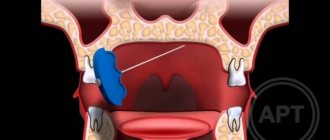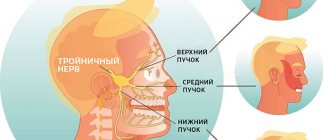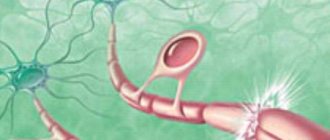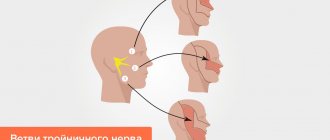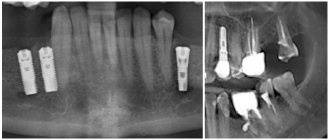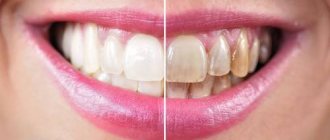Causes of inflammatory damage to the trigeminal nerve
Factors contributing to inflammation of the trigeminal nerve are:
- surgical interventions on the jaw bones;
- fractures of the base of the skull, lower and upper jaws;
- tumors;
- complex tooth extraction;
- hypothermia;
- surgery on the maxillary sinus;
- improperly administered anesthesia;
- incorrectly performed dental prosthetics;
- metabolic disorders;
- the presence of foreign bodies that irritate the nerve trunk or injure nerve endings;
- bacterial or viral infection;
- various types of intoxication of the body;
- hypovitaminosis;
- weakening of the immune system.
Causes of trigeminal neuralgia
Why and how does such severe pain occur? There is no final answer yet, although the search for it has been going on for centuries.
One of the immediate causes of pain is considered to be the destruction of the “insulation” of the nerve - the so-called. myelin sheath, when it is inflamed. In this case, “short circuits” and “leakages” of the electrical signal occur outside the nerve fiber. As a result of the chaotic involvement of a large number of neurons in the process of excitation, pain occurs.
The immediate cause of destruction of the myelin sheath can be:
- viral infection (poliomyelitis, neuro-AIDS, herpes);
- autoimmune process (for example, with multiple sclerosis);
- mechanical compression of the trigeminal nerve fibers inside or outside the skull.
Nerve compression is caused by:
- hemorrhages (stroke);
- dilation and curvature of blood vessels (atherosclerosis, aneurysms);
- facial and head injuries;
- pathology of the maxillary system;
- neoplasms;
- the presence of adhesions (for example, due to meningitis), etc.
Nerve degeneration sooner or later leads to malfunctions in the “remote control” of its control—the sensory and motor nuclei located in the brain. And it even contributes to the formation of areas of increased excitability - the so-called. epileptic foci. Damage to the nuclei can also be primary (its causes are also present in the above list).
Symptoms of trigeminal neuritis
The maxillary trigeminal nerve consists of three types of nerve fibers:
- vegetative;
- motor;
- sensitive.
The symptomatic picture of neuritis may vary depending on which fibers were affected by the inflammatory process.
Damage to sensory fibers
In particular, with inflammation of the sensory fibers, the patient may complain of a tingling sensation, numbness, and weakened sensitivity in the area innervated by the trigeminal nerve.
Damage to motor fibers
When motor fibers are damaged, there is a partial or complete decrease in strength in the innervated muscles, their atrophy and deterioration of tendon reflexes.
Damage to vegetative fibers
When the vegetative fibers are inflamed, the patient experiences cyanosis and swelling of the skin, dryness and thinning of the skin, and the potential risk of developing a trophic ulcer increases.
Psychosomatics in the treatment of trigeminal neuralgia
From the point of view of the psychosomatic approach, a symptom is a bodily expression of an unresolved problem at the level of the human psyche. Like a red light on a dashboard, it signals problems and draws our attention to them. Awareness and resolution of the problem lead to healing and, as a result, to the disappearance of symptoms that become unnecessary (the red light changes to green). Sometimes psychological work to change lifestyle (mental, emotional, physical habits) is enough for complete recovery. Sometimes the body needs additional help in the form of one or another cleansing and healing effect.
Rudiger Dahlke and Thorvald Detlefsen in the book “Disease as a Path” advise people suffering from trigeminal neuralgia to ask themselves questions that will help find the root of the problem and its solution: 1. What pain is written on my face? Where is my sensitivity impaired? 2. What prevents me from feeling at ease? 3. What criticism do I have to hide? 4. What does a “bad game” mean when I put on a “good face”? 5. Who were the intended recipients of the suppressed blows that “burn” on my face? 6. Where do I lack self-affirmation? 7. What does my accumulated energy want to do now?
Make an appointment
Pain due to inflammation
In addition, a disease such as inflammation or neuritis of the facial trigeminal nerve makes itself felt with attacks of pain of a very diverse nature:
- cutting,
- burning,
- pricking,
- tearing
- shooting, etc.
In this case, the area of pain does not always correspond to the area of innervation and can spread to the lower jaw, cheeks and chin.
Pain may be accompanied by:
- muscle spasms (facial, chewing),
- the appearance of nasal discharge,
- development of hypersalivation,
- increased lacrimation.
Lack of sensation in the tongue, lips and chin
With inflammatory damage to the trigeminal nerve, not only the entire nerve can be damaged, but also its individual branches. This is why numbness and pain can occur in various areas of the face. For example, when the lingual branch of the nerve is inflamed, patients complain of pain and sensitivity disturbances in the anterior part of the tongue, and when the mental branch is damaged, in the area of the lips and chin.
Pain when laughing, chewing, brushing teeth and shaving
Pain due to neuritis of the maxillary trigeminal nerve can intensify with touching, chewing, laughing and with changes in temperature. That is why patients, trying to prevent the recurrence of painful attacks, avoid excessive mobility and prolonged conversations, and refuse brushing their teeth and shaving.
Symptoms of inflammation of the trigeminal nerve
As a rule, neuritis does not affect all branches of the trigeminal nerve. Most often, inflammation occurs in the maxillary region, so pain occurs while eating or brushing teeth.
Characteristic symptoms of the disease
- Pain. Shooting, pronounced, paroxysmal. With extensive damage, attacks last several minutes and are repeated at regular intervals.
- Impaired facial expressions and decreased sensitivity of facial muscles.
- Temperature, taste disturbance, lacrimation. These symptoms manifest themselves individually and depend on the form and severity of the disease.
Treatment of neuritis of the maxillary trigeminal nerve
Therapy
The treatment program for trigeminal neuritis is drawn up taking into account the causes of the disease and its clinical signs. The main goals of treatment are:
- achieving a sensitizing effect;
- fight against bacterial and viral infection;
- increasing the body's immune forces;
- elimination of swelling of the nerve trunk;
- restoration of natural adaptive and compensatory reactions;
- normalization of the patency of nerve impulses.
Healing procedures
The set of procedures aimed at blocking the inflammatory process and eliminating all manifestations of neuritis includes:
- antibacterial therapy;
- antiviral therapy;
- elimination of factors contributing to the occurrence of intoxication;
- removal of tumor-like neoplasms or dissection of adhesions compressing the nerve;
- prescribing vitamin and mineral complexes to the patient;
- stimulation of nerves and muscles;
- acupuncture;
- physiotherapy (electrophoresis, phonophoresis, UHF, ultrasound, paraffin therapy).
People suffering from trigeminal neuritis are advised to regularly visit dental clinics and have their oral cavity sanitized.
Trigeminal neuralgia. Treatment
Pain is a symptom of the disease and at the same time the cause of its worsening. Ordinary, strong analgesics do not relieve pain. Even such radical measures as cutting the branches of the nerve bring only temporary relief, since with the regeneration of the nerve the pain also “regenerates”. In the treatment of trigeminal neuralgia, a combination of anticonvulsants (effective for epilepsy), muscle relaxants, antihistamines and sedatives, vitamins, nutritional correction, massage, and physiotherapeutic procedures is now actively used. At the same time, they try to identify and eliminate the cause of central or peripheral nerve damage - acute and chronic diseases of the ENT organs, vascular disorders, pathologies of the dental system, tumors, consequences of head injuries, etc.
The big disadvantage of drug therapy for neuralgia is its duration (sometimes even lifelong) and strong side effects on other organs (for example, on the gastrointestinal tract), which aggravates metabolic disorders and closes a vicious circle.
An alternative option for a comprehensive, or more precisely, holistic impact on the cause-and-effect mechanisms of disease development are holistic methods - acupuncture, homeopathy, osteopathy, herbal medicine, qigong therapy, diet therapy. These methods break the vicious circle, restore the movement of energy and fluids in the body, and release its protective and healing reserves.
At Dr. Sager's clinic in Moscow, these methods are used to treat trigeminal neuralgia, both in combination with each other and with conventional drug therapy (with a course of reducing the dose of medications until they are completely discontinued), and as monotherapy. It all depends on the results of individual diagnostics.
Causes of trigeminal nerve disease
- Hypothermia of the body and especially the face;
- Head or face injuries;
- Chronic kidney disease;
- Dental diseases;
- Meningitis;
- Presence of multiple sclerosis;
- Metabolic disease.
Trigeminal nerve disease can be caused by your daily facial skin care routine. In pregnant women, the trigeminal nerve is also often inflamed or when the monthly cycle is disrupted.
Compresses
The simplest heating is done using a hard-boiled chicken egg. A hot egg is pressed against the area of inflammation or rolled along the nerve. This procedure can be used only after acute inflammation has resolved. At the stage of acute nerve inflammation, any heating is excluded.
Heat a handful of buckwheat in a dry frying pan, pour into a linen bag and apply to the affected area of the face. As a hot compress, along with buckwheat, you can use salt or flax seeds, which need to be steamed over boiling water.
Hot mud applications (Taman, Tambukan mud) help with neuralgia. To do this, a soft hot cake is made from mud, which is applied to the sore spot. You can add a small amount of vinegar to the healing mud.
Infuse four teaspoons of crushed (dried) marshmallow roots in a glass of water for several hours. Soak gauze folded in several layers with this infusion. Apply to the affected area of the face.
Rubbing
Essential oils are used to rub into painful areas of the face. Garlic, radish juice, honey have a warming effect and are useful for Wind disorders, therefore they are also recommended for local rubbing.
- Fir oil should be used in a mixture with vegetable or ghee in a ratio of one to five. Gently rub into painful spots with your fingertips. Lavender oil is used in the same way.
- Garlic oil is mixed with vodka - one drop per glass (50 ml). Rubbed into sore areas. Almond oil is used in the same way.
- You can also rub black radish juice, honey dissolved in water or a 10% mummy solution into painful points.
- You can use 20% propolis tincture in alcohol for rubbing, mixed in equal parts with vegetable oil.
- A good warming remedy in Tibetan medicine for neuralgia is a mixture of ghee, garlic, and hot red pepper. This mixture should be gently rubbed onto the affected area of the face, especially trigger points. This mixture is recommended in the treatise “Zhud-Shi” as a medicine against Wind disorders for internal or external use.
- Cut a clove of garlic in half and wipe the cut on painful areas of the face.
- For rubbing, you can use pure fir oil, moistening a cotton pad or cotton pad with a small amount.
Infusions, decoctions, teas
For anti-inflammatory, soothing teas and decoctions, you can use flowers and herbs of St. John's wort, oregano, motherwort, lavender flowers, and valerian roots.
- In the evening, pour two tablespoons of dried fireweed tea into 500 ml of boiling water, keep in a thermos overnight, and drink the next day.
- Brew two tablespoons of chamomile flowers with a glass of boiling water (you can use other proportions). This tea has a calming and anti-inflammatory effect.
- Add 1 teaspoon of honey and 0.2 g of mumiyo to a glass of hot milk. Stir until completely dissolved. Drink before bed.
- Combine dried marshmallow roots, mint and chamomile in equal proportions. Brew three tablespoons of this mixture with a liter of boiling water in a thermos. After 3 hours, strain and drink half a glass three times a day.
- Peppermint tea has a good calming effect. To prepare it, add 1 teaspoon of dry mint herb to a glass of boiling water and brew for 15 minutes.
How to use class=”aligncenter” width=”992″ height=”247″[/img]
or call +7 Moscow
Free consultation Survey, examination, pulse diagnostics from 30 minutes
Diagnostics Ultrasound, MRI, Laboratory tests (as prescribed)
Treatment Individual plan
